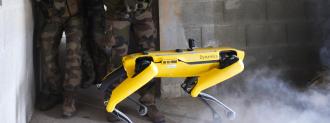Boston Dynamics largely gives its customers free reign over its robot dog Spot — after all, when someone spends $75,000 on a robot dog, they don’t expect limitations on how they can use it.
One of the only applications the company prohibits in its terms of service, though, is the use of the robot dog as a weapon — but a French military school has just sent Spot trotting into a decidedly gray area.
A Military Robot Dog
The Special Military School of Saint-Cyr — the French version of West Point — recently posted photos on Twitter of Spot being used as a military robot during combat training exercises.
French newspaper Ouest-France reported that students ran three scenarios with Spot and several other robots — an offensive action, a defensive action (performed during the day and at night), and an urban combat exercise.
Each exercise was completed with a robot and then again without it, so that the students could compare.
Exactly what Spot did during its time as a military robot isn’t clear, but based on the photos, no one strapped a machine gun to its back or anything like that — Ouest-France’s report suggests it was used for reconnaissance, to scope out the scene ahead of the students.
Students told the paper that the military robots slowed them down, and Spot’s battery actually died in the middle of one exercise. However, the robot dog also helped them stay safe.
“During the urban combat phase where we weren’t using robots, I died,” one student said. “But I didn’t die when we had the robot do reconnaissance first.”
Boston Dynamics’ Take
Michael Perry, Boston Dynamics’ VP of business development, told the Verge that the company knew that one of its European distributors — Shark Robotics — had sold a Spot to Saint-Cyr, but it was not aware that the robot dog was going to be used for these combat exercises.
“We’re learning about it as you are,” Perry said. “We’re not clear on the exact scope of this engagement.”
However, he also said that Boston Dynamics is still evaluating whether military customers should be allowed to deploy the robot dog for uses that aren’t designed to directly harm an enemy.
“We think that the military, to the extent that they do use robotics to take people out of harm’s way, we think that’s a perfectly valid use of the technology,” Perry said.
“With this forward-deployment model that you’re discussing, it’s something we need to better understand to determine whether or not it’s actively being used to harm people.”
Killer Robots?
Hearing about Spot’s use as a military robot might draw to mind images of killer machines gunning people down, but the robot dog really could save lives on the battlefield, one day.
I didn’t die when we had the robot do reconnaissance first.
A Saint-Cyr Student
A surprise during combat can lead to countless deaths, so recon and surveillance are vital to any military. In the past, a small unit of soldiers might have ventured ahead of the rest to scope out the scene — and sometimes, get caught or killed in the process.
Today, drones, satellites, and other technologies can fill in for those soldiers — in that sense, a robot dog like Spot could be just another tool keeping soldiers safe.
At the same time, drones might have started out as surveillance tools, but eventually, someone decided they’d be useful for attacks, too — and Boston Dynamics’ terms and conditions might not be enough to deter a military from doing the same with Spot if it wanted to.
We’d love to hear from you! If you have a comment about this article or if you have a tip for a future Freethink story, please email us at [email protected].






